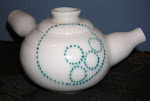I started this post a month or more ago and never posted it. Here it is!
Art matters. Art has been part of my life since I was old enough to say the word. In fact, I think that art is inextricably tied to who I am. I've had conversations with people over the years about a lot of related ideas -- the value of sadness, the importance of feeling emotions*, seeing beauty in traditionally ugly things, and understanding "angst." But at the root, I think it all comes back to art.
To really explain how I feel about art, I think I should start by explaining what art is to me. I know it's different to everyone, so I don't want to claim that this is
the definition of art, just that it's
my definition. Art is any creation (visual, audible, tangible, etc) that deliberately expresses something about the artist's experience of the world. In other words, something I create is art if I intentionally created it to communicate my feelings about any aspect of my life, experience, environment, imagination, etc. I think "good" art is good in that it expresses the artists intent successfully. Craft is an essential aspect of art, in that the craftsmanship of the art can add or detract from the success of the piece in communicating its intent. But something can be well crafted and not successful art if it does not express anything (which, of course, is in the eye of the beholder). That doesn't mean it is not valuable in its own right, just that it doesn't fit
my definition of art.
So. Why is art important to me? Because I think that
feelings and
experience are valuable. Each of us has a unique life experience. Because of that unique experience, we see the world in different ways. We see beauty in different things, and we are hurt by different things. By sharing our experience through art, we give each other the opportunity to learn and grow. We are inspired by others' creativity. We feel connected to each other in a way that spans distance and time. My life is made richer by seeing bits of the world through the filter of other artists' creations, and I feel less alone when I see my own experience mirrored in their work.
I know that not everyone shares my definition of art, and not everyone values it the way I do. My mother has never understood why I want people I date to get the concept of angst. My favorite artwork has always been more about negative emotions and difficult experiences. It's easy to see beauty in the beautiful, and reflecting that beauty back takes skill, but maybe not so much depth. Seeing beauty in sadness and using pain to create something that resonates with others is what captivates me
.
This is something I struggle with in my own art. While pottery is my (current) medium of choice, I have yet to make anything that comes from that same depth of emotion that I value in other artists' work. The piece I just finished (popularly known as Snork Bottles) comes the closest. It's about the connections between people--conversations, cliques, families, and the feeling of being with, but still removed from the rest of the group. People seem to like it but they don't necessarily see the message I'm trying to convey with it. I'm afraid that the cuteness of the bottles gets in the way of the message.
My other work is more about the process of pottery--the feeling of the clay, the physical evidence (or lack of evidence) of the artist in the finished piece. It's experimental, interesting and fun but doesn't come from great depth of feeling.
Since I was a child, I've felt the need to express something through my artwork. I've created many pots, poems, drawings, paintings, sculptures that I'm proud of, but nothing that scratches that itch.
Maybe that's how it's supposed to be. Maybe once I create a piece that successfully communicates all the emotions I had as a 13 year old sitting in the crook of an oak tree writing incomprehensible poems and drawing pictures of wild roses, or all the thoughts that ran through my head as a college student listening to Love Hangover, drinking whiskey and drawing nudes out of an old Playboy at 2am, I'll be done and there won't be anything left to say.
(*
The Giver by Lois Lowry and
Eternal Sunshine of the Spotless Mind are two of my favorite stories about the importance of feeling negative emotions.)



















